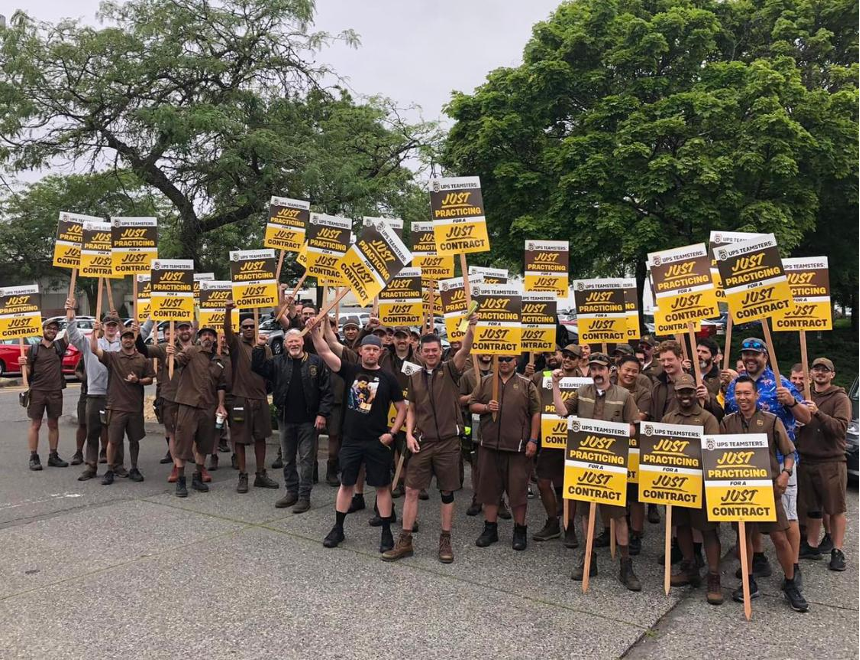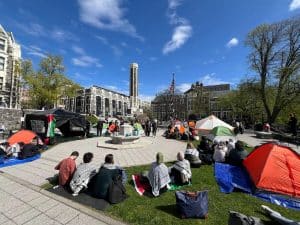On Wednesday, July 5, contract negotiations between UPS and the Teamsters union collapsed. The Teamsters tweeted that UPS had “walked away from the bargaining table” at 4:00 A.M. after “presenting an unacceptable offer” that “did not address members’ needs.” It was unanimously rejected by the UPS Teamsters National Negotiating Committee.
From the start, UPS had continuously called for a ”cost-neutral” contract during the economic negotiations, which required “give-and-take from both sides.” Despite having record profits during the pandemic and generating more than $100 billion in revenue last year, the company continues to refuse to address UPS workers’ main demands, particularly in regard to part-time workers.
This negotiating approach by the billion-dollar corporation, and the decades of large sellouts by the previous Teamsters leadership, is what The New York Times recalls as a “relationship [which] has been a role model for interactions between business and organized labor.” This has also meant the Amazonification and Uberization of the workforce, including increased surveillance and harassment, grueling schedules, a fast work pace, poverty wages, increased subcontracting, and denial of basic rights like a proper AC system, among other anti-worker measures.
The leaders of the International Brotherhood of Teamsters (IBT) walked out of negotiations on June 27, demanding that UPS abandon ”cost-neutral bargaining” and make a more serious counter-offer. The next day, the UPS bargaining team resubmitted the exact same proposal, demanding the same givebacks and concessions that had been rejected previously. As negotiations began to break down, tensions ran high. IBT president Sean O’Brien gave UPS until June 30 to present a ”last, best, and final offer.” Later, this deadline was extended to Wednesday, July 5 when the negotiations collapsed.
While there is still a long way to go, and there will likely be new updates on the negotiations soon, a national UPS strike now seems more likely than at any point in the last 25 years. With expectations raised among the membership, O’Brien will not be able to easily backtrack, even if he wanted to. He has promised the moon, pledging to secure a ”historic” contract for UPS’s nearly 340,000 unionized workers, including its majority part-time workforce. The proof will be in the pudding. At the time of writing, the O’Brien leadership is coming under increasing pressure to release more information to Teamster members about the union’s specific economic demands.
The Contract Fight
Initially, the workers’ credible strike threat appeared to have won some important demands, including ending the draconian two-tier system among drivers, securing Martin Luther King, Jr. day as a paid holiday, installing AC in new trucks (though solutions are still needed for this extreme summer), and ending the company’s ability to force workers in on their day off.
However, an array of crucial issues remain unsettled, such as outsourcing, pension contributions, longer breaks, progression to top-pay, and perhaps the most urgent topic of all: major raises for all UPS warehouse employees, known as “inside workers.” Ultimately, Teamsters will need to read the fine print of any tentative agreement and vote on whether to accept it. ”No concessions” means not only preserving hard-won rights but also substantially improving pay, safety, and overall working conditions.
This contract fight is already having national repercussions and it can drastically improve conditions for the most precarious sector: part-time UPS employees who are disproportionately Black, Brown, and immigrant workers, often working two or more jobs to make ends meet. Inside workers who load, unload, and sort every UPS package have become the majority of the UPS workforce and make up the Teamsters ”sleeping giant.” With the union advocating for major wage increases and longer breaks for part timers, now is the time for this sleeping giant to wake up and fight. Among rank-and-file part-timers, groups like Teamsters Mobilize are demanding a $25/hour starting wage and catch-up raises for current inside workers.
However, many demands have not yet been mentioned, such as extending the guaranteed 3.5-hour workday for part-timers, reducing the wait time for accessing healthcare benefits, or even equality with full-timers. Until the beginning of the 1980s, part-time workers received the same hourly rate as drivers. However, over the last four decades, the wages for inside workers have stagnated while Package Car Drivers (the people who drive the iconic brown trucks) have seen their pay increase. The union as a whole should take up the fight for true equality for inside workers, demanding equal, or at least comparable, pay across classifications. By overcoming the disparities that exist within the workforce, Teamsters can build greater unity, and set the stage for helping to organize other workplaces, such as Amazon.
Getting Ready to Strike
To build membership participation and turn up the heat on UPS, Teamsters launched “practice picketing” across the country. So far, thousands of workers have already joined in these actions and momentum is clearly on the side of this massive, essential workforce. Labor leaders and other working-class allies have publicly expressed their solidarity with the Teamsters, vowing to support UPS workers should they go on strike. The power of a UPS strike would be greatly magnified by other unions honoring Teamster picket lines and refusing to transport any UPS goods.
As rank-and-file activist Greg Kerwood put it:
We NEED a strike to unite our members at UPS, and our Teamsters Union as a whole. We NEED a strike to create a generation of militant Unionists, whose education will be the picket line, and whose graduation will be the launch of a new Labor movement. We NEED a strike to create the bonds that hold Labor together, that unite workers; those that can only be forged in the furnace of workplace action. We NEED a strike to energize the entire Labor movement; to show workers that they CAN stand up, that they CAN fight back, and that they CAN win. We NEED a strike to remind the corporations of the world just who generate the record profits they enjoy year after year.
At the same time, Teamster leadership has not made clear for the membership what the main economic demands are, especially on the matter of wages. Although the UPS offer was leaked, nothing has been published in terms of what the union demanded from the company. While the union leadership is providing semi-regular updates and is doing a better job than the old, discredited James Hoffa, Jr. leadership did, O’Brien agreed to a Non Disclosure Agreement (NDA) which serves to keep members in the dark about key aspects of negotiations. At present, it looks like members will only have full access to any Tentative Agreement (TA) after it is accepted by the union leadership.
Publicly taking up the demand for $25/hour and catch-up raises for inside workers is key to winning the most from UPS and fortifying the resolve of inside workers to participate in the strike. Workers deserve and need more clarity about what exactly they will be going on strike for. This will also amplify the solidarity with our possible strike, stating clearly that our economic demands can also rally millions of precarious, part-time, and logistic workers who want to take up this struggle in their workplaces too, for example at Amazon and FedEx.
Organizing the Part-Timers
While many are noting that the Teamsters are more unified as a union than at any time in recent memory, union militants are also facing the challenge of trying to overcome decades of demoralization and bitterness brought on from past leadership selling out. But by grappling with the problem, union members can at least identify and build towards solutions. And a militant strike is itself one of the best ways to win the hearts and minds of the workforce and draw new layers into union activism.
Among the top strategic challenges faced by the union is the need to mobilize and organize the rank and file, especially the 60 percent who work part time. Among part-timers, many never meet their shop steward, learn the contract, or attend a union meeting. In fact, this sector often sees the union as an organization that mainly defends the interests of drivers and ignores the plight of preload, offload, small sort, and other worker classifications. The fact that during this contract negotiation part timers’ demands have been part of the strike issues opens the door to advance in organizing this sector.
So far, most of the practice picketing activities have been aimed towards drivers — while part timers make up the majority of the UPS workforce, they have not been given the space to flex their strike muscles. Generating part timers’ enthusiasm and engagement is not only key to holding a national strike, but also to achieving long-term organizing and to enforcing the future contract.
Rank-and-file formations like Teamsters Mobilize are making efforts to organize the part-time workers in multiple states. In their last statement they wrote:
With negotiations at a standstill, we, the UPS Teamsters rank-and-file call on Teamsters President Sean O’Brien and the UPS Teamsters National Negotiating Committee to continue to reject any future offers that fall short of meeting our basic demands. Additionally, we call on all rank-and-file UPS Teamsters to take up the task of organizing our fellow workers into a unified force prepared to hit the streets on August 1st for the largest strike against a private employer in US history.
Teamsters Mobilize has also been pushing for a petition demanding “a base wage of $25/hr, $0.75 in catch up raises for each year of service, and 5% raises over the life of the contract.”
As the July 31 contract expiration quickly approaches, building democratic shop floor organization among the rank and file will be key. Union members must take up everything from parking lot meetings, rallies, and practice picketing to breakfast meetings, interacting with media, and circulating petitions. Workers have the ability to make signs, leaflets, use social media, and educate members to be ready to vote no if a contract doesn’t meet their demands.
Learn more about part-timers: “Grueling Working Conditions and Low Wages”: A Testimonial from a UPS Warehouse Worker
Solidarity With UPS workers
On August 1, more than 340,000 UPS Teamsters could go on strike. If we add their families, this contract fight will directly affect more than a million people. It will have an encouraging effect on Amazon and FedEx workers and have a ripple effect beyond the logistics sectors. This could be a historic opportunity to set the tone for workers’ struggle to come.
UPS workers are not only numerically strong, but occupy a strategic position in the U.S. economy, moving 6 percent of the country’s GDP, and over 3 percent of the global GDP, every single day. A strike against the logistics giant would deal a huge blow to the bosses, inspiring millions of workers to rise up. With today’s generation of wage slaves who are fed up with decaying work conditions and bleak futures, support for unions is near an all time high. Winning a strong contract can serve to change the conditions of exploitation not just in UPS, but for the entire U.S. working class.
Going on strike isn’t easy, and much will be at stake, especially for workers who live paycheck to paycheck. UPS will call in their favors with politicians, judges, police, and the state in general to secure an outcome favorable to them. This could mean police harassing workers at picket lines, judges putting conditions and limits on our picket lines, or politicians saying that is time to accept an offer and call off the strike. At the same time, Teamsters have a massive strike fund, and all striking workers who report to picket duty will be paid between $200-400 per week in strike pay (five times one’s monthly dues).
The Teamsters leadership’s friendly relationship with the Democrats doesn’t guarantee that the government will be on our side. With presidential campaigns already in full swing, many politicians will posture as “friends of Labor” to garner support for themselves and their political allies. However, as soon as a strike becomes too militant or begins to disrupt the economy too much, they will betray their promises and side with the billionaire UPS bosses. Despite all the solidarity tweets that Democrats are making with our contract fight, UPS workers should treat capitalist politicians with extreme caution and skepticism.
Last year, the Democratic Party played a vital role in forcing a tentative agreement on railroad workers, breaking what would have been a historic strike. While UPS workers are not subject to the Railway Labor Act, we should be under no illusions that politicians are our friends. When DHL Teamsters from local 251 went on strike last year in Providence, Rhode Island, cops attacked the picket lines and arrested union leaders in an attempt to break the strike. To this betrayal of workers we can add the Supreme Court’s recent 8-1 ruling in favor of the employer in Glacier Northwest Inc v. Teamsters Local 174, sending the case back to Washington State court to be litigated.
A Teamsters victory will mean a victory for workers everywhere, and we can help revitalize the labor movement. Already, we see a new energy in this movement, with workers at companies like Amazon, Starbucks, Apple, Trader Joe’s, and many others are fighting to unionize their workplaces and get a first contract. In other sectors, like education, healthcare, and manufacturing, workers are going on strike to fight for better working conditions.
Our working conditions and wages have been eroded by economic crises, the pandemic, high inflation, and profit-hungry corporations. The struggle at UPS can become a point of reference for the broader working class, especially among this new, energetic sector emerging within organized labor. This sector of workers — many of whom are already standing together in solidarity by attending each other’s rallies and actions — must be ready to join in more combative actions like strikes and picket lines.
Spread the word: join a practice picket, come to a rally, be ready to support our strike!











